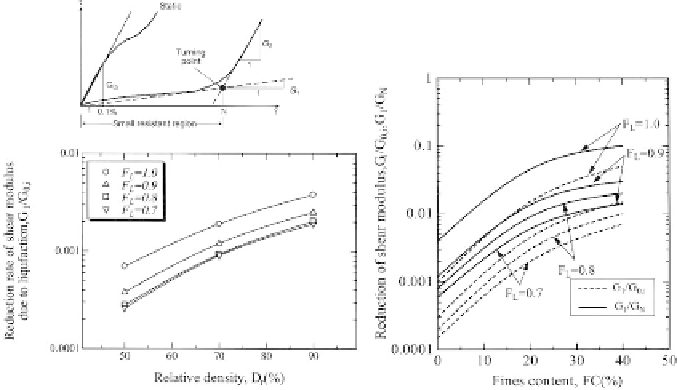Geoscience Reference
In-Depth Information
Fig. 11.7. Basic elements and definitions for the ALID approach. (a) Initial and
post-liquefaction shear stress-strainrelationship, (b) effect of relative density and
liquefaction factor of safetyon degraded shear modulus, and (c) effect of fines and
liquefaction factor of safetyon degraded shear modulus (after Yasuda, 2004)
showsreasonableconsistencyforlargesettlementvalues(
>
0
.
60m)andacleartendency
for underprediction forsmaller ones.
3. Numerical analysis of liquefaction performance
In the sequel, the aforementioned approaches of Naesgaard et al. (1997) and Cascone
and Bouckovalas (1998) are followed up, under the light of new, mostly numerical evi-
dence, obtained from dynamic fully coupled effective stress analyses calibrated against
the results of centrifuge tests. Details on this algorithm, that incorporates a modified
version of the bounding surface critical state model of Papadimitriou and Bouckovalas
(2002)anditsexperimentalverificationarepresentedinanotherpaperofthisconference
(Andrianopoulosetal.,2007),andelsewhere(Andrianopoulosetal.,2005,2006;Bouck-
ovalas et al., 2005), and consequently they will not be repeated here in any extent. It is
only briefly mentioned that the reliability of the analyses was checked against three dif-
ferent series of centrifuge tests, namely VELACS models 1, 2 and 12 (Arulmoli et al.,
1992; Carnevale andElgamal, 1993; Farrell and Kutter, 1993; Krsteljand Prevost, 1993)
which model seismic liquefaction under level or slightly sloping ground conditions, as
well as theseismicresponse of a rigid foundation over liquefied soil.
The configuration for VELACS Model 12 experiment, which is directly related to the
topic of this article, is shown in Figure 11.8. Furthermore, Figure 11.9 shows typical
comparisons between numerical predictions and experimental measurements of excess

